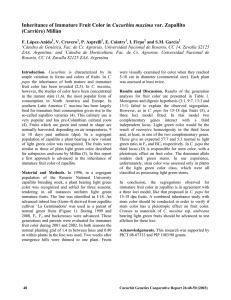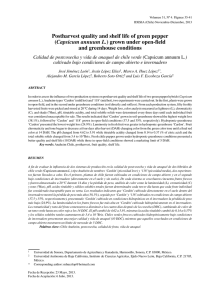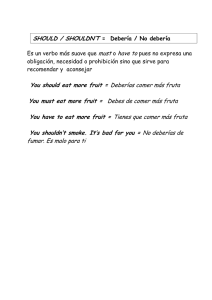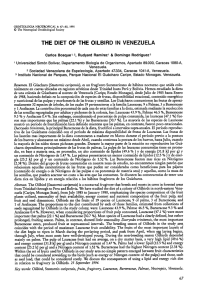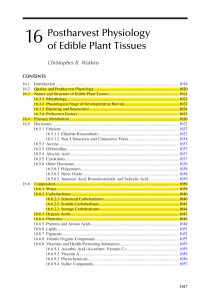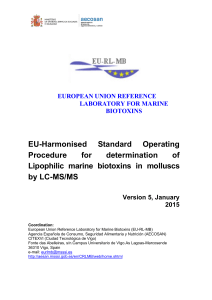PHYSICAL CHARACTERIZATION OF GULUPA FRUITS (Passiflora
Anuncio
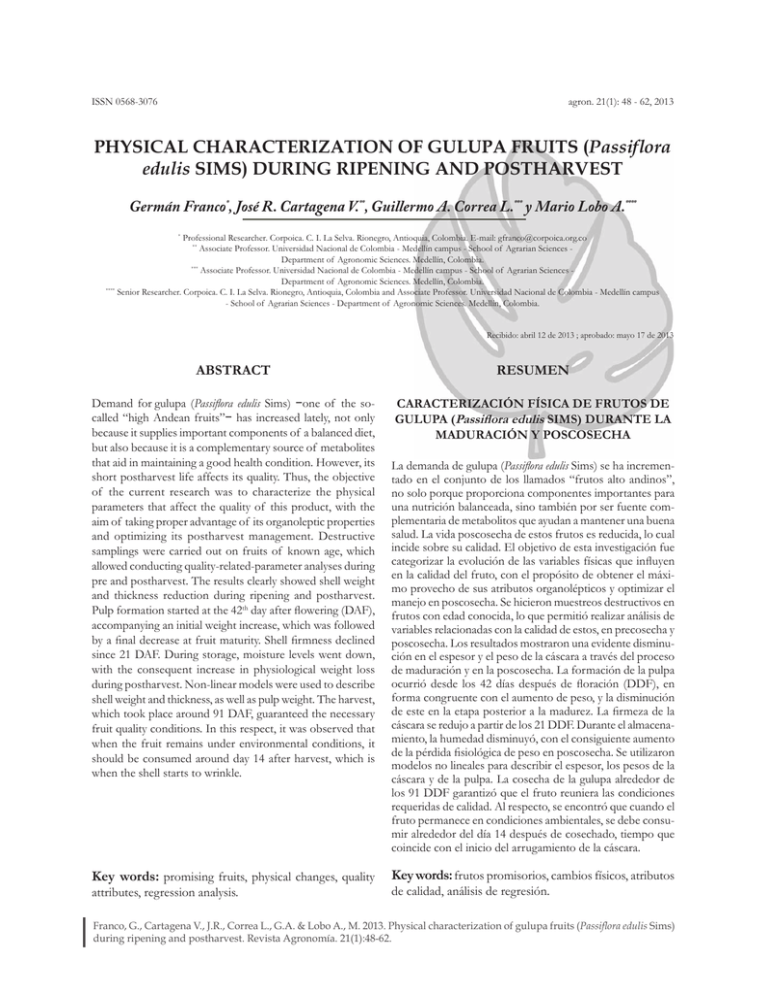
ISSN 0568-3076 agron. 21(1): 48 - 62, 2013 PHYSICAL CHARACTERIZATION OF GULUPA FRUITS (Passiflora edulis SIMS) DURING RIPENING AND POSTHARVEST Germán Franco*, José R. Cartagena V.**, Guillermo A. Correa L.*** y Mario Lobo A.**** Professional Researcher. Corpoica. C. I. La Selva. Rionegro, Antioquia, Colombia. E-mail: [email protected] ** Associate Professor. Universidad Nacional de Colombia - Medellín campus - School of Agrarian Sciences Department of Agronomic Sciences. Medellín, Colombia. *** Associate Professor. Universidad Nacional de Colombia - Medellín campus - School of Agrarian Sciences Department of Agronomic Sciences. Medellín, Colombia. **** Senior Researcher. Corpoica. C. I. La Selva. Rionegro, Antioquia, Colombia and Associate Professor. Universidad Nacional de Colombia - Medellín campus - School of Agrarian Sciences - Department of Agronomic Sciences. Medellín, Colombia. * Recibido: abril 12 de 2013 ; aprobado: mayo 17 de 2013 aBstRaCt ResUMeN Demand for gulupa (Passiflora edulis Sims) −one of the socalled “high Andean fruits”− has increased lately, not only because it supplies important components of a balanced diet, but also because it is a complementary source of metabolites that aid in maintaining a good health condition. However, its short postharvest life affects its quality. Thus, the objective of the current research was to characterize the physical parameters that affect the quality of this product, with the aim of taking proper advantage of its organoleptic properties and optimizing its postharvest management. Destructive samplings were carried out on fruits of known age, which allowed conducting quality-related-parameter analyses during pre and postharvest. The results clearly showed shell weight and thickness reduction during ripening and postharvest. Pulp formation started at the 42th day after flowering (DAF), accompanying an initial weight increase, which was followed by a final decrease at fruit maturity. Shell firmness declined since 21 DAF. During storage, moisture levels went down, with the consequent increase in physiological weight loss during postharvest. Non-linear models were used to describe shell weight and thickness, as well as pulp weight. The harvest, which took place around 91 DAF, guaranteed the necessary fruit quality conditions. In this respect, it was observed that when the fruit remains under environmental conditions, it should be consumed around day 14 after harvest, which is when the shell starts to wrinkle. CaRaCteRiZaCiÓN FÍsiCa De FRUtOs De GULUPa (Passiflora edulis siMs) DURaNte La MaDURaCiÓN Y POsCOseCHa Key words: promising fruits, physical changes, quality attributes, regression analysis. La demanda de gulupa (Passiflora edulis Sims) se ha incrementado en el conjunto de los llamados “frutos alto andinos”, no solo porque proporciona componentes importantes para una nutrición balanceada, sino también por ser fuente complementaria de metabolitos que ayudan a mantener una buena salud. La vida poscosecha de estos frutos es reducida, lo cual incide sobre su calidad. El objetivo de esta investigación fue categorizar la evolución de las variables físicas que influyen en la calidad del fruto, con el propósito de obtener el máximo provecho de sus atributos organolépticos y optimizar el manejo en poscosecha. Se hicieron muestreos destructivos en frutos con edad conocida, lo que permitió realizar análisis de variables relacionadas con la calidad de estos, en precosecha y poscosecha. Los resultados mostraron una evidente disminución en el espesor y el peso de la cáscara a través del proceso de maduración y en la poscosecha. La formación de la pulpa ocurrió desde los 42 días después de floración (DDF), en forma congruente con el aumento de peso, y la disminución de este en la etapa posterior a la madurez. La firmeza de la cáscara se redujo a partir de los 21 DDF. Durante el almacenamiento, la humedad disminuyó, con el consiguiente aumento de la pérdida fisiológica de peso en poscosecha. Se utilizaron modelos no lineales para describir el espesor, los pesos de la cáscara y de la pulpa. La cosecha de la gulupa alrededor de los 91 DDF garantizó que el fruto reuniera las condiciones requeridas de calidad. Al respecto, se encontró que cuando el fruto permanece en condiciones ambientales, se debe consumir alrededor del día 14 después de cosechado, tiempo que coincide con el inicio del arrugamiento de la cáscara. Key words: frutos promisorios, cambios físicos, atributos de calidad, análisis de regresión. Franco, G., Cartagena V., J.R., Correa L., G.A. & Lobo A., M. 2013. Physical characterization of gulupa fruits (Passiflora edulis Sims) during ripening and postharvest. Revista Agronomía. 21(1):48-62. Physical characterization of gulupa fruits (Passiflora edulis Sims) during ripening and postharvest agron. 21(1): 48 - 62, 2013 iNtRODUCtiON 49 Most of the studies conducted on this topic have dealt with yellow and purple passion fruit materials planted in hot climate areas. References about gulupa are certainly scarce, which makes it necessary to characterize this material under the conditions of the Colombian Andean tropic, given that its composition might be different from that of the studied purple passion fruits. A research conducted by Pruthi (1963) indicates that mature fruits of purple passion fruit harvested every two weeks from the same orchard showed highly significant differences in all their physicochemical features, except for reducing sugars. The same author manifests that the chemical composition of purple passion fruit is very changeable and likely to be affected by factors such as ripeness, plant condition, harvest time, climate, cultivation site and cultivar itself (Tucker, 1993; Jaramillo et al., 2000). At a global level, there is a growing tendency to increase the consumption of fruits and vegetables, whose nutraceutical properties as well as their vitamin, mineral and fiber contents certainly strengthen human health, thus constituting important components of human nutrition. The mentioned preference is motivated by a growing concern about a balanced diet, containing fewer carbohydrates, fats and oils, as well as more vegetables (López, 2003). Usually traded fresh, the so-called “High Andean” fruits are commonly appraised as pleasant (Ávila et al., 2007; Márquez et al., 2007) and highly demanded products on the part of consumers. However, these fruits have a short post-harvest life, during which they rapidly deteriorate and lose quality. A broad set of Andean fruits, among which we can count gulupa (Passiflora edulis Sims), have been prospected and found to have The harvest of gulupa is carried out from a rough some good agronomic possibilities (Lobo, 2000). estimate of the fruits aspect on the plant because, Fruit progress during ripening and postharvest has on the one hand, there are no indicators for such been studied in several species and from different purpose, as it could be the case of ripening stage, perspectives. Some examples are provided by tree color, size, weight and ripening indexes (Pinzón tomato [Cyphomandra betacea (Cav.) Sendt], blackberry et al., 2007); and on the other hand, because its (Rubus spp.), guava (Psidium guajava L.), pineapple postharvest behavior has not been studied yet. In [Ananas comosus (L.) Merr], pitahaya [Selenicereus studying fruits from the municipality of Venecia, megalanthus (Haw) Britt & Rose], melon (Cucumis melo Cundinamarca (Colombia), the mentioned authors L.), passion fruit (Passiflora edulis Sims var. flavicarpa), developed a seven-degree color scale from which they zapote negro (Diospyros digyna Jacq), lulo (Solanum recommended stage 3 as the optimal harvest time. quitoense Lam) and rambutan (Nephelium lappaceum In addition, they mention that polar and equatorial L.), among others. These studies are mainly aimed diameters of this fruit are 50 and 56 mm, respectively, at understanding postharvest behavior in order to and that they decreased during ripening, as well as maintain consumption quality, thus taking advantage shell thickness and firmness; while the maximum of the nutraceutical properties of this products fruit weight is reached at ripening stage zero (0), with (Araújo et al., 1997; Pinzón, 2000; Silva & Mercadante, 55.8 g; and maximum pulp weight was observed at 2002; Ordóñez et al., 2004; Villanueva et al., 2004; stages three (3) and four (4), with 27.3 g. Shiomi et Arellano et al., 2005; Kafkas et al., 2006; Menéndez et al. (1996b) state that this fruit can be harvested at its al., 2006; Márquez et al., 2007; Saradhuldhat & Paull, half ripe stage, when low temperature transportation 2007; Centurión et al., 2008; Yingsanga et al., 2008). is available, which allows commercializing the fruit in However, up to date, little information is available variable distant places. In a study on curuba (Passiflora about several fruits with good economic potential in mollisima Bailey), which is related to gulupa, Ceballos tropical zones, which has determined their deficient et al. (2002) found that physiological maturity takes place between days 72 and 97 after flowering (DAF), postharvest management protocols. 50 Germán Franco, José R. Cartagena V., Guillermo A. Correa L. y Mario Lobo A. depending on the material, as also found by Shiomi et al. (1996a) in gulupa. Once the fruit has been harvested, it does not receive the normal supply of water, minerals, and organic molecules such as sugars and hormones. Nevertheless, most fruit tissues are able to transform their components, through physiological processes, which might be advantageous or harmful for product quality. The intensity of these processes determines the product’s shelf life. A fruit’s growth and its physiological maturation are completed when it is attached to the plant; nevertheless, organoleptic maturation and senescence might continue after it has been detached from the plant (Wills et al., 1984; Haard, 1985). Fruit softening is an integral part of the ripening process in almost all cases. Alteration of the intercellular structure and degradation of the materials that make up the cell wall, namely cellulose, hemicellulose and pectic material, seem to be an early event associated to the solubilization of protopectinas that ussualy remain insoluble (Leshem et al., 1986; Brady, 1987). From a biological standpoint, these changes are important because they imply cell wall transformations that are not observed during leaf senescence, probably taking place only in abscission zones (Brady, 1987). From a commercial standpoint, this is certainly an important process, because postharvest life is reduced to a considerable extent by increased fruit softening, which, in turn, determines higher susceptibility to physical and phytosanitary damage during this period (Leshem et al., 1986; Brady, 1987). During postharvest, the behavior of gulupa fruits harvested at different ripening stages and stored at 25ºC has shown linear weight losses, young fruits being the ones that lose more weight (Shiomi et al., 1996a). These authors found that shelf life of the fruits they harvested between 60 and 70 DAF was shorter than that of those harvested between 80 and 90 DAF. Gutiérrez (2010) observed a weight loss of up to 8% in fruits stored at 8ºC for 40 days; while those kept in three different packings lost 2.4%, 0.012% and 0.014% of their weight. Thus, the objective of the present research was to study the progress of the physical parameters that affect the quality of gulupa fruits under the conditions of the Colombian Lower Montane rain forest, for farmers to use this data in plantation management decisions. MateRiaLs aND MetHODs Location. An experimental crop was planted in the municipality of Rionegro, Department of Antioquia, at “La Selva” Research Center, which belongs to the Colombian Corporation of Agricultural Research Corpoica (6o7’46.41’’ North, 75o24’51.77’’ West; 2090 masl; average yearly temperature, precipitation and relative humidity (RH) records of 17ºC, 1917 mm, and 78%, respectively; average sunshine of 1726 hours/year; and yearly average evapotranspiration of 1202 mm). According to Holdridge Ecological Life Zones, the experimental site corresponds to a Lower Montane rain forest (LM-rf). Instrumental evaluation was carried out at the Quality Analysis Laboratory of Corpoica. Biological material. Research was conducted on 10 gulupa materials from the departments of Antioquia, Putumayo and Nariño (Colombia), which make part of the Colombian National Germplasm Bank, administered by Corpoica. Ortiz (2010) reported low genetic variability in these materials, which were analyzed through AFLPs (Amplified Fragment Length Polymorphism) and SSRs (Simple Sequence Repeats). Fruit growth was assessed by color thread labeling of flowers at their homogamous stage, with and without hercogamy, following the protocol proposed by Ángel et al. (2011). This stage was taken as day zero of fruit age, after which sampling dates were recorded as Days After Flowering (DAF). Physical characterization of gulupa fruits (Passiflora edulis Sims) during ripening and postharvest experimental procedure. All analyses involved destructive samplings every seven days since 7 DAF and until 112 DAF. Fruit physiological progress during postharvest was evaluated by sampling since 91 DAF and then every seven days until day 21 after harvest. These (after harvest) sampling dates corresponded to 98, 105 and 112 DAF, thus allowing the comparison of these fruits to those that were allowed ripening on the vine. The sampling unit for each fruit age under study was made up of 10 fruits, which were transported to the laboratory in an expanded polystyrene box containing dry ice to keep an approximate internal temperature of 4ºC. Postharvest fruit progress was evaluated at 20ºC and 70% RH. The moment of harvest for this study was 91 DAF, when the fruit is usually harvested for exportation. The measurements were carried out on days 14 and 21 after harvest. Juice extraction was done by cutting the fruits along the equatorial zone. The pulp was immediately separated from the seeds by sieving it through a piece of tulle. Then, the juice was kept in an ice-refrigerated recipient. Fruit form (cm). It was calculated as the ratio between the polar diameter (PD) and the equatorial diameter (ED). shell thickness (cm) [epicarp plus mesocarp, (Orjuela et al., 2011)]. It was measured using a caliper (L&W Tools®). shell weight (g). This parameter was assessed individually in a Mettler® PE 360 scales. agron. 21(1): 48 - 62, 2013 Pulp weight (g) [endocarp]. It was measured in a Mettler® PE 360 scales. seed weight (g). After separating the seeds, this parameter was also measured on a Mettler® PE 360 scales. 51 Fruit firmness (kgf). It was carried out at room temperature (20±1°C) on a TA-TX Plus® texturometer equipped with a P25-S probe, under the following specifications: compression mode, pre-test speed of 1.5 mm sec-1, test speed of 2.0 mm seg-1, post-test speed of 10 mm seg-1, and distance of 15 mm. Fruit moisture (%). Initially, the fruits were individually weighed in grams on a Mettler® PE 360 scales. Then, they were taken to a Venticell® 111 oven at 70ºC, where they were dried until constant weight, to finally calculate moisture by the following expression: Physiological weight loss during postharvest (PWL) (%). It was determined as the difference between initial and final fruit weights: In order to analyze the behavior of the studied fruit parameters such as firmness, shell thickness, pulp, shell and seed weight, a series of non-linear models proposed by Kiviste et al. (2002) were applied, namely the Allometric, Exponential, Terazaki, Korf, Gemesi, Korsun, Gram, Sloboda, Verhulst-logistica, Wingert, Pearl-reed, Simek, Moiseev III, MonomolecularWeber, Todorovic III, Var der vliet, Kovessy, Thomasius I, Thomasius II, Bass, Gompertz, Gompertz-wenk, Mitscherlich I, Bertalanffy, Weibull II, Weibull II and Mitscherlich III models. Fruit age expressed in DAF was used as the predictive variable. For each parameter, the best fitting model was selected, i.e., the one with the most homogeneous distribution of residuals, the highest prediction determination coefficient (R2 pred), the least Mean Squared Error, and the lowest statistic PRESS value. Fruit parameters were evaluated through mean comparison (t test) between same-aged samples of fruits on and off the vine. 52 Germán Franco, José R. Cartagena V., Guillermo A. Correa L. y Mario Lobo A. ResULts aND DisCUssiON Fruit form. The ratio between the polar diameter (PD) and the equatorial diameter (ED) was interpreted as corresponding to elongated (PD/ED = 2.0) or rounded (PD/ED = 1.0) forms. It exhibited relatively large values until 21 DAF, thus indicating an ellipsoid fruit form. Then, it tended to stabilize around values somewhat larger than 1.0 along the development period (Figure 1), which reveals how the fruit acquires its characteristic ovoid form, thus paralleling the findings of Orjuela et al. (2011) on this same fruit. Fruit form being a species-specific and cultivar-specific feature (González et al., 2001), it was studied by Pruthi (1963) in a series of gulupa related passiflora fruits. These authors reported ovoid forms in yellow and purple passion fruits and an oval-oblong form for granadilla (Passiflora ligularis Juss). Determining dominant fruit form is important when it comes to designing appropriate packagings for the transportation and exhibition of the product. Figure 1. Progress of the PD/ED ratio (fruit form) during gulupa fruit development (Passiflora edulis Sims). Bars indicate standard deviation. Physical characterization of gulupa fruits (Passiflora edulis Sims) during ripening and postharvest shell thickness. The fruits that ripened on the plant registered values between 0.47 and 0.54 cm, which are similar to those reported by Orjuela et al. (2011). This parameter ranged from 0.29 to 0.12 cm in off the vine fruits, which is considerably lesser than the range exhibited by the fruits on the vine (Figure 2). Pinzón et al. (2007) and Orjuela et al. (2011) consider that this reduction is a consequence of the ripening process, which leads the pulp to occupy a larger space. The progress of shell thickness during ripening was adequately described by Korsun’s model, with an R2 pred. Value of 0.86 (Table 1 and Figure 3). Figure 2. Shell thickness progress during development and postharvest of gulupa (Passiflora edulis Sims) fruits. Bars indicate standard deviation. agron. 21(1): 48 - 62, 2013 53 Figure 3. Shell thickness progress in gulupa (Passiflora edulis Sims) fruits according to age. The solid line indicates estimation by Korsun’s model. Dotted lines indicate 95% confidence limits for expected values. Circles indicate observed values. 54 Germán Franco, José R. Cartagena V., Guillermo A. Correa L. y Mario Lobo A. shell weight. This parameter exhibited a tendency to decline during growth and development, ranging from 28.9 to 29.9 g in mature fruits (Figure 4), which corresponds to the upper limit of the results found by Orjuela et al. (2011) also in mature fruits (21 to 28 g). Shell weight showed a constant decrement in fruits off the vine, with values that were significantly different from those of the fruits that ripened on the plant (Table 2). This behavior is consistent with shell thickness progress during postharvest, which is due to the continuity of catabolic processes determining not only the loss of water but the impossibility to recover it as well. Shell weight progress over time was adequately described by Korsun’s model, with an R2 pred value of 0.72 (Table 1 and Figure 5). 2 table 1. Estimators of Korsun’s model Y = e a+b In(DDF)-c [In(DDF)] and goodness of fit statistics employed for gulupa (Passiflora edulis Sims) fruit development analysis PRESS Variable Shell thickness Shell weight Pulp weight Mean Squared Error Model parameters a = -44.2834 b = 21.5504 c = 2.6513 a = -64.1565 b = 32.5833 c = 3.9237 a = -34.5045 b = 17.3743 c = 1.9993 R2pred 0.36153 0.059574 0.86246 2.475.18 4.89465 0.72302 1.104.49 3.27538 0.37318 table 2. Mean comparison between gulupa (Pasiflora edulis Sims) components in same-age fruits on and off the vine Fruit age on the vine (off the vine) (DaF) Mean shell weight (g) Mean pulp weight (g) Mean seed weight (g) On the vine Off the vine On the vine Off the vine On the vine 98 (91 + 7) 29.38 a 15.99 b 25.36 a 21.98 b 6.61 a 105 (91 + 14) 28.94 a 10.59 b 27.26 a 21.35 b 6.76 a 4.90 b 112 (91 + 21) 29.97 a 7.06 b 26.60 a 19.96 b 6.63 a 4.41 b Means of variable with different letters within a row are different at α = 0.01 level, according to T-test. Off the vine 4.23 b Physical characterization of gulupa fruits (Passiflora edulis Sims) during ripening and postharvest 55 Figure 4. Gulupa (Passiflora edulis Sims) fruit composition during development and postharvest. Bars indicate standard deviation. agron. 21(1): 48 - 62, 2013 Figure 5. Gulupa (Passiflora edulis Sims) fruit shell weight progress according to age. The solid line indicates estimation by Korsun’s model. Dotted lines indicate 95% confidence limits for expected values. Circles indicate observed values. Pulp weight. The pulp started forming by 42 DAF, which is longer than the 30 DAF reported by Shiomi et al. (1996b). This part of the fruit followed an opposite trend to the shell, that is, while the latter decreased, the former increased (Figure 4), as also reported by García (2008) in granadilla. This implies that the pulp acquires a larger mass within the fruit. Nevertheless, the current work found a steady tendency in gulupa once it had reached 91 DAF. In studying yellow passion fruit, Villanueva et al. (1999) observed a pulp content increase, which went from a 30%-31% range 42 DAF to a 36%-39% one 77 DAF. In turn, Pruthi (1963) has reported pulp contents of 30.9% in mature fruits of yellow passion fruit, thus paralleling the results of the present research, in which the pulp was observed to reach even higher records than those reported by the mentioned authors. This is also in agreement 56 Germán Franco, José R. Cartagena V., Guillermo A. Correa L. y Mario Lobo A. with results by Arjona et al. (1991), who expressed that pulp yield changes according to the variety. In effect, they found a higher pulp weight reduction in purple passion fruit than in yellow passion fruit and maypop (Passiflora incarnata). In gulupa, Pinzón et al. (2007) estimated that maximum pulp weight (27.3 g) is reached at stages three (3) and four (4) of the color scale they proposed. In turn, Orjuela et al. (2011) found values ranging between 15 and 26 g, which are similar to those obtained in ripe fruits by the present research (25.3 to 25.8 g). In addition, we found that pulp weight declined constantly under postharvest conditions, showing highly significant differences with those fruits that were allowed ripening on the plant (Table 2). This sets a contrast with the results of Villanueva et al. (1999), who observed an increase in passion fruit juice content (7.2% to 13.5%) after five days of storage at room conditions, which they attributed to fruit weight loss. In the present case, pulp weight progress over time was adequately explained by Korsun’s model, with an R2 pred. value of 0.37 (Table 1 and Figure 6). Weight of the seeds. By 50 DAF, the seeds had almost reached their final size, after which a steady trend was observed in seed weight both during pre and postharvest (Figure 4). The significant differences we observed between these two stages (Table 2) could be attributed to seed moisture content. As to the weight percentage participation of the components of the studied fruit, the shell was found to represent 47%, followed by the pulp with 41%, and then the seeds with 11%. These results are similar to those of Orjuela et al. (2011), who found a seed weight range of 9% to 11%; but they contrast with those of Medina et al. (2000), who reported a higher value (15%), both works dealing with gulupa fruits. In turn, Pruthi (1963) observed records of 13.6% and 7.4% for this parameter in purple and yellow passion fruit, respectively. Figure 6. Gulupa (Passiflora edulis Sims) fruit pulp weight progress according to age. The solid line indicates estimation by Korsun’s model. Dotted lines indicate 95% confidence limits for expected values. Circles indicate observed values. Firmness. This parameter showed an outstanding reduction since 21 DAF (Figure 7), to reach values around 5.3 kgf by 105 DAF. This coincides with previous reports by Rodríguez & García (2010), who found that resistance to penetration diminished after the fourth week, to reach values of about 5.1 kgf in mature fruits. Leshem et al. (1986) consider that this is an early event probably associated to the solubilization of usually insoluble protopectinas. González et al. (2001) have explained softening as Physical characterization of gulupa fruits (Passiflora edulis Sims) during ripening and postharvest the result of changes in cell wall thickness caused by the dissolution of the middle lamella and the simultaneous modification of the permeability of the plasmalema, whose selectivity is thus reduced, resulting in increased intercellular spaces that are filled with water and gases, all of which produces the softening of the tissues. Although the process seems to mainly imply the degradation of pectic material, some other degradation events might also be involved (Leshem et al., 1986). Giovannoni et al. (1989) state that the depolymerization of pectin due to the activity of endopolygalacturonase is not enough by itself to affect texture. Softening can be the result 57 of the action of other enzymes and changes in the concentration of organic acids, other chelating agents or cell wall pH. Miller (1986), Brady (1987) and Fry et al. (2001) report that oxygen reactive species (ROS) also play a role in the degradation of the cell wall. Since 105 DAF, there was an increase in firmness due to the fact that the fruit becomes elastic as a consequence of softening, thus leading the measuring probe to register higher values. This situation was more evident after harvest, when firmness (under the conditions established for its assessment) could not be measured any later than 91 + 7 DAF (Figure 7) because the probe could not penetrate the fruit shell. agron. 21(1): 48 - 62, 2013 Figure 7. Gulupa (Passiflora edulis Sims) fruit firmness progress during development and postharvest. Bars indicate standard deviation. Moisture. This parameter showed a decreasing trend, with initial values of 92%, final records of 81%, and a more pronounced decrement after 98 DAF (Figure 8). Orjuela et al. (2011) have reported that the gulupa fruit is rich in water, reporting contents of about 90%, as also found in the current work, but contrasting with reports by Rodríguez & García (2010), who found a water content of 55.7%. The presence of this element in the fruit is due to the fact that the parenchymatous tissue, which features fleshy berries, accumulates it in considerable amounts, thus resulting in a succulent fruit (González et al., 2001). A strong decrement in water content was observed during postharvest between 91 + 7 DAF and 91 + 14 DAF, due to the catabolic activity implied in respiration, which results in water losses that cannot be compensated. Highly significant differences were observed between the fruits on and off the vine (Table 3), which allows concluding that water loss 58 Germán Franco, José R. Cartagena V., Guillermo A. Correa L. y Mario Lobo A. is more critical for the latter. Fruit water loss led to shell wrinkling, which was evident after 14 days under the storage conditions of this experiment. Due to visual evaluation on the part of the consumer, shell wrinkling can negatively affect commercialization. Physiologic weight loss during postharvest. This parameter was observed to increase along the experiment in the fruits harvested and maintained at ambient conditions (Figure 9). This coincides with the findings of Shiomi et al. (1996a) and Sierra et al. (2011) in gulupa; and of Gómez et al. (1999) in yellow passion fruit. The latter researchers reported an accumulated weight loss of 81.4 g after 18 days under plastic bag storage conditions, which is larger than the record of the present research, thus suggesting that water loss is higher in passion fruit than in gulupa. Figure 8. Water content progress during development and postharvest of gulupa (Passiflora edulis Sims) fruits. Bars indicate standard deviation. Figure 9. Physiological weight loss progress in gulupa (Passiflora edulis Sims) fruits during post harvest. Bars indicate standard deviation. Physical characterization of gulupa fruits (Passiflora edulis Sims) during ripening and postharvest 59 table 3. Mean comparison for water content in same age gulupa (Pasiflora edulis Sims) fruits on and off the vine Fruit age on the vine (off the vine) (DaF) Water content (%) On the vine Off the vine 98 (91 + 7) 82.82 a 76.66 b 105 (91 + 14) 80.38 a 67.22 b 112 (91 + 21) 80.90 a 67.26 b Means with different letters within a row are different at α = 0.01 level, according to T-test. CONCLUsiONs The results obtained in gulupa fruits regarding form, shell thickness and firmness, moisture content, shell, pulp and seed weight correspond to those found in previous works on gulupa related passifloras. agron. 21(1): 48 - 62, 2013 Due to the properties they confer to the fruit, features such as form, moisture content, and shell thickness and firmness should be taken into account in the postharvest management and packaging design of this product. The information obtained for the studied parameters allowed establishing a physical standard for this fruit. Some nonlinear models adequately accounted for the progress of some of this fruit’s physical parameters, thus appearing as potentially useful to monitor its final quality. 60 Germán Franco, José R. Cartagena V., Guillermo A. Correa L. y Mario Lobo A. ReFeReNCes Ángel C., C., Nates P., G., Ospina T., R., Melo O., C.D. & Amaya M., M. 2011. Biología floral y reproductiva de la gulupa Passiflora edulis Sims f. Edulis. Caldasia. 33(2):433-451. Araújo, F., Quintero, S., Salas, J. Villalobos, J. & Casanova, A. 1997. Crecimiento y acumulación de nutrientes del fruto de guayaba (Psidium guajava L.) del tipo “Criolla Roja” en la planicie de Maracaibo. Rev. Fac. Agron. (LUZ). 14:315-328. Arellano G., L.A., Saucedo V., C. & Arévalo G., L. 2005. Cambios bioquímicos y fisiológicos durante la maduración de frutos de zapote negro (Diospyros digna Jacq.). Agrociencia. 39:173-181. Arjona, H.E., Matta, F.B. & Garner Jr., J.O. 1991. Growth and composition of passion fruit (Passiflora edulis) and mayop (P. incarnata). HortScience. 26(7):921-923. Ávila R., H.G., Cuspoca R., J.A., Fischer, G., Ligarreto M., G.A. & Quicazán de Cuenca, M.C. 2007. Caracterización fisicoquímica del fruto de agraz (Vaccinium meridionale Swartz) almacenado a 2°C. Revista Facultad Nacional de Agronomía, Medellín. 60(2):4179-4193. Brady, C.J. 1987. Fruit ripening. Annu. Rev. Plant. Physiol. 38:155-178. Ceballos P., A.D. Aristizábal L., J.C., Alba T., L. & Márquez O., S.M. 2002. Estudio comparativo sobre el comportamiento fisiológico de la maduración de los frutos y la evaluación fisicoquímica y poscosecha, en cuatro variedades de curuba cultivadas en la granja Tesorito de la Universidad de Caldas. En: Memorias IV Seminario Nacional de frutales de clima frío moderado (pp. 93-99). Centro de Desarrollo Tecnológico de Frutales. Medellín, Antioquia, Colombia. Centurión Y., A.R., Solís P., S., Saucedo V., S., Báez S., R. & Sauri D., E. 2008. Cambios físicos, químicos y sensoriales en frutos de pitahaya (Hylocereus undatus) durante su desarrollo. Fitotecnia Mexicana. 31(1):1-5. Fry, S.C., Dumville, J.C. & Miller, J.G. 2001. Fingerprinting of polysaccharides attacked by hydroxyl radicals in vitro and in the cell walls of ripening pear fruit. Biochemical Journal. 357:729-737. García M., M.C. 2008. Manual de manejo cosecha y poscosecha de granadilla. Corpoica. Bogotá. Giovannoni, J., Dellapenna, D., Bennett, A. & Fischer, R. 1989. Expression of a chimeric polygalacturonase gene in transgenic rin (ripening inhibitor) tomato fruit results in polyuronide degradation but not fruit softening. Plant Cell. 1:53-63. Gómez P., K., Ávila, E. & Escalona, A. 1999. Curva de crecimiento, composición interna y efecto de dos temperaturas de almacenamiento sobre la pérdida de peso de frutos de parchita ‘Maracuya’ (Passiflora edulis f. flavicarpa Degener). Rev. Fac. Agron. 25(2):125-137. González, D.V., Hernández, M.S., Herrera, A., Barrera, J.A., Martínez, O. & Páez, D. 2001. Desarrollo del fruto e índices de cosecha de la carambola (Averrhoa carambola L.) producida en el piedemonte amazónico colombiano. Agronomía Colombiana. 18(1-2):7-13. Gutiérrez C., L.A. 2010. Desarrollo de un empaque polimérico con propiedades anti-empañantes apropiado para la comercialización de gulupa (Passiflora edulis Sims f. edulis). Tesis Magíster en Ciencias - Química. Universidad Nacional de Colombia, Facultad de Ciencias, Departamento de Química. Bogotá D.C., Colombia. Haard, N.F. 1985. Características de los tejidos de las plantas comestibles. En: Fennema, O.R. (ed.). Introducción a la Ciencia de los Alimentos (pp. 861-867). Reverté, S.A., Barcelona. España. Jaramillo C., B.E., Torres A., M.L., Pinzón F., M.I. & Franco, G. 2000. Caracterización y cuantificación de azúcares y ácidos no volátiles en tres materiales de mora (Rubus glaucus Benth) por cromatografía líquida de alta eficiencia. En: Memorias 3 Seminario de Frutales de clima Frío Moderado (pp. 330-335). Centro de Desarrollo Tecnológico de Frutales. Manizales, Colombia. Physical characterization of gulupa fruits (Passiflora edulis Sims) during ripening and postharvest 61 Kafkas, E., Koar, M., Türemi, N. & Baer, K.H.C. 2006. Analysis of sugars, organic acids and vitamin C contents of blackberry genotypes from Turkey. Food Chemistry. 97(4):732-736. Kiviste, A., Álvarez, J.G., Rojo, A. & Ruiz, A.D. 2002. Funciones de crecimiento de aplicación en el ámbito forestal. Ministerio de Ciencia y Tecnología. Instituto Nacional de Investigación y Tecnología Agraria y Alimentaria INIA. Forestal 4. Madrid. Leshem, Y., Abraham, H., Halevy, A. & Chaim F., Ch. 1986. Fruit ripening. Developments in Crop Science. 8:162-210. Lobo, M. 2000. Papel de la variabilidad genética en el desarrollo de los frutales andinos como alternativa productiva. En: Memorias 3 Seminario de Frutales de Clima Frío Moderado (pp. 27-36). Centro de Desarrollo Tecnológico de Frutales. Manizales, Colombia. López C., A.F. 2003. Manual para la preparación y venta de frutas y hortalizas. Del campo al mercado. En: Organización de las Naciones Unidas para la Agricultura y la Alimentación FAO (ed.). Boletín de Servicios Agrícolas de la FAO. 151:95-111. Roma. Márquez C., C.J., Otero E., C.M. & Cortés R., M. 2007. Cambios fisiológicos, texturales, fisicoquímicos y microestructurales del tomate de árbol (Cyphomandra betacea S.) en poscosecha. VITAE. 14(2):9-16. Medina C., C.I., Lobo A., M. & Correa R., R.D. 2000. Caracterización morfológica y química de pasifloras andinas como apoyo al desarrollo de estas especies. En: memorias 3er Seminario de Frutales de Clima Frío Moderado (pp. 13-18). Centro de Desarrollo Tecnológico de Frutales. Manizales, Colombia. Menéndez A., O.M., Evangelista L., S., Arenas O., M., Bermúdez T., K., Martínez, A. & Jiménez A., A. 2006. Cambios en la actividad de α-amilasa, pectinmetilestrasa y poligalacturonasa durante la maduración del maracuyá amarillo (Passiflora edulis var. flavicarpa Degener. Interciencia. 31(10):728-733. Miller, A.R. 1986. Oxidation of cell wall polysaccharides by hydrogen peroxide: a potential mechanism for cell wall breakdown in plants. Biochem. Biophys. Res. Commun. 141:238-244. Ordóñez, R.M., Vattuone, M.A. & Isla, M.I. 2004. Changes in carbohydrate content and related enzyme activity during Cyphomandra betacea (Cav.) Sendt fruit maturation. Postharvest Biology and Technology. 35(2005):293-301. Orjuela B., N.M., Campos A., S., Sánchez N., J., Melgarejo, L.M. & Hernández, M.S. 2011. Manual de manejo poscosecha de gulupa (Passiflora edulis Sims). En: Melgarejo, L.M. & Hernández, M.S. (eds.). Poscosecha de la Gulupa (pp. 7-22). Universidad Nacional de Colombia, sede Bogotá. Bogotá D.C. Ortiz V., D.C. 2010. Estudio de la variabilidad genética en materiales comerciales de gulupa (Passiflora edulis f. edulis Sims) en Colombia. Tesis Magíster en Ciencias Agrarias. Genética y Fitomejoramiento, Universidad Nacional de Colombia, sede Bogotá. Bogotá D.C. Pinzón F., M.I. 2000. Propiedades físicas de cosecha y poscosecha de frutos de lulo “La Selva”. En: memorias 3 Seminario de Frutales de Clima Frío Moderado (pp. 386-397). Centro de Desarrollo Tecnológico de Frutales. Manizales, Colombia. Pinzón, I.M., Fischer, G. & Corredor, G. 2007. Determinación de los estados de madurez del fruto de la gulupa (Passiflora edulis Sims). Agronomía Colombiana. 25(1):83-95. agron. 21(1): 48 - 62, 2013 Pruthi, J.S. 1963. Physiology, chemistry, and technology of passion fruit. Advances in Food Research. 12:203-282. Rodríguez, M. & García, C. 2010. Poscosecha, procesamiento y análisis nutracéutico de gulupa (Passiflora edulis Sims.) y curuba (Passiflora tripartita var. mollisima). En: Memorias Primer Congreso Latinoamericano de Pasifloras (p. 107). Corporación centro de investigación para la gestión tecnológica de passiflora en el departamento del Huila. Neiva, Colombia. Saradhuldhat, P. & Paull, R.E. 2007. Pineapple organic acid metabolism and accumulation during fruit development. Scientia Horticulturae. 112(3):297-303. 62 Germán Franco, José R. Cartagena V., Guillermo A. Correa L. y Mario Lobo A. Sierra A., C.A., Gutiérrez C., L.A. & Martínez, S.M. 2011. Desarrollo de empaques poliméricos apropiados para la comercialización de gulupa en fresco. En: Melgarejo, L.M. & Hernández, M.S. (eds.). Poscosecha de la gulupa (Passiflora edulis Sims) (pp. 23-32). Universidad Nacional de Colombia, sede Bogotá. Bogotá D.C. Shiomi, S., Wamocho, L.S. & Agong, S.G. 1996a. Ripening characteristics of purple passion fruit on and off the vine. Postharvest Biology and Technology. 7(1-2):161-170. Shiomi, S., Kubo, Y., Wamocho, L.S., Koaze, H., Nakamura, R. & Inaba, A. 1996b. Postharvest ripening and ethylele biosynthesis in purple passion fruit. Postharvest Biology and Technology. 8(3):199-207. Silva, S.R. & Mercadante, A.Z. 2002. Composição de carotenóides de maracujá-amarelo (Passiflora edulis flavicarpa) in natura. Cienc. Tecnol. Aliment. 22(3):254-258. Tucker, G.A. 1993. Introduction. En: Seymour, G., Taylor, J. & Tucker, G. (eds.). Biochemistry of Fruit Ripening (pp. 1-51). Chapman & Hall. London, U.K. Villanueva A., R., Evangelista L., S., Arenas O., M.L., Díaz P., J.C. & Bautista B., S. 1999. Evaluación de la calidad del jugo de maracuyá (Passiflora edulis) durante el crecimiento del fruto. Revista Chapingo Serie Horticultura. 5(2):95-101. Villanueva, M.J., Tenorio, M.D., Esteban, M.A. & Mendoza, M.C. 2004. Compositional changes during ripening of two cultivars of muskmelon fruits. Food Chemistry. 87(2):179-185. Wills R., H.H., Lee, T.H., McGlasson, W.R., Hall, E.G. & Graham, D. 1984. Fisiología y manipulación de frutas y hortalizas postrecolección. Acribia, Zaragoza, España. Yingsanga, P., Srilaong, V., Kanlayanarat, S., Noichinda, S. & McGlasson, W.B. 2008. Relationship between browning and related enzymes (PAL, PPO and POD) in rambutan fruit (Nephelium lappaceum Linn.) cvs. Rongrien and See-Chompoo. Postharvest Biology and Technology. 50(2-3):164-168.
